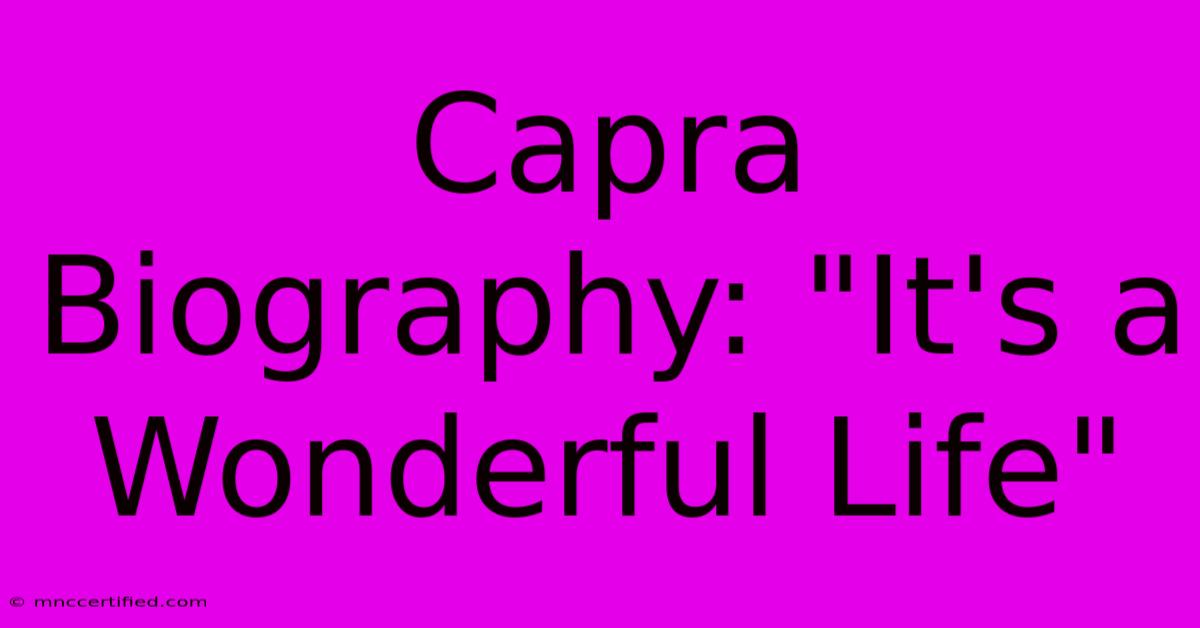Capra Biography: "It's A Wonderful Life"

Table of Contents
Capra's "It's a Wonderful Life": A Biography of the Film and its Enduring Legacy
Frank Capra's It's a Wonderful Life is more than just a classic Christmas film; it's a cinematic testament to the power of human connection, the importance of community, and the enduring spirit of hope. This article delves into the biography of the film itself, exploring its production, its initial reception, and its remarkable journey to becoming a beloved holiday staple. We'll also examine the enduring relevance of its themes in today's world.
The Genesis of a Classic: From Novel to Screen
The film's story begins not with Capra, but with Philip Van Doren Stern's 1939 short story, "The Greatest Gift." This tale, about a man who learns the impact of his life through a heavenly intervention, resonated deeply with Capra, a filmmaker known for his sentimental yet socially conscious narratives. He acquired the rights and spent years developing the story, refining its themes and characters to fit his vision. The process was far from smooth, with several script revisions and casting challenges.
Overcoming Production Hurdles: A Difficult Journey to the Screen
The production of It's a Wonderful Life wasn't without its difficulties. Financial constraints hampered the production, leading to compromises and delays. The film's ambitious special effects, particularly the sequences depicting George Bailey's alternate reality, pushed the boundaries of cinematic technology at the time. Furthermore, the film's release during the post-World War II era presented a challenge, as audiences were perhaps less receptive to the film's sentimental tone compared to the more hard-hitting narratives prevalent at that time.
A Box Office Flop? Re-examining the Initial Reception
Contrary to its current status as a beloved classic, It's a Wonderful Life was initially a box office disappointment. Its lengthy running time, its sentimental approach, and the prevalence of other, more commercially successful films, led to its relative failure upon release. This initial lack of commercial success led to a period of obscurity for the film, despite the exceptional performances and technical achievements.
The Rise of a Christmas Tradition: A Slow but Steady Climb
The film's rediscovery is a fascinating story in itself. Copyright issues allowed for widespread television broadcasts in the 1970s, inadvertently transforming It's a Wonderful Life into a cherished Christmas tradition. Repeated airings during the holiday season cemented its place in popular culture, effectively building its current iconic status.
The Enduring Legacy: Themes that Resonate Across Generations
The enduring appeal of It's a Wonderful Life lies in its timeless themes. The film explores fundamental human experiences:
- The importance of community: The film highlights the interconnectedness of lives and the significance of positive relationships.
- The value of ordinary lives: George Bailey's journey shows that even seemingly insignificant actions can have a profound ripple effect.
- The power of hope and redemption: Despite facing adversity, George ultimately finds meaning and purpose in his life.
- The enduring spirit of Christmas: The film beautifully captures the spirit of generosity, compassion, and goodwill towards others.
These themes resonate with audiences across generations, making the film both relevant and enduring.
Conclusion: A Timeless Classic
Frank Capra's It's a Wonderful Life is more than just a film; it's a cultural touchstone. Its journey from a box office flop to a beloved Christmas classic is a testament to the power of storytelling and the enduring appeal of its timeless themes. The film continues to inspire and uplift audiences, proving its enduring legacy as one of cinema's greatest achievements. Its impact on audiences, particularly during the holiday season, speaks volumes about the human desire for connection, hope, and the celebration of life's simple joys. Its biography is as rich and complex as the story it tells.

Thank you for visiting our website wich cover about Capra Biography: "It's A Wonderful Life". We hope the information provided has been useful to you. Feel free to contact us if you have any questions or need further assistance. See you next time and dont miss to bookmark.
Featured Posts
-
Christmas Restaurants Nyc To Portland
Dec 25, 2024
-
Mc Donalds Christmas Hours Open Or Closed
Dec 25, 2024
-
Avalanche Kills Swiss Snowboarder Hediger
Dec 25, 2024
-
Share Merry Christmas Wishes
Dec 25, 2024
-
Olympic Snowboarder Hediger Dies In Avalanche
Dec 25, 2024